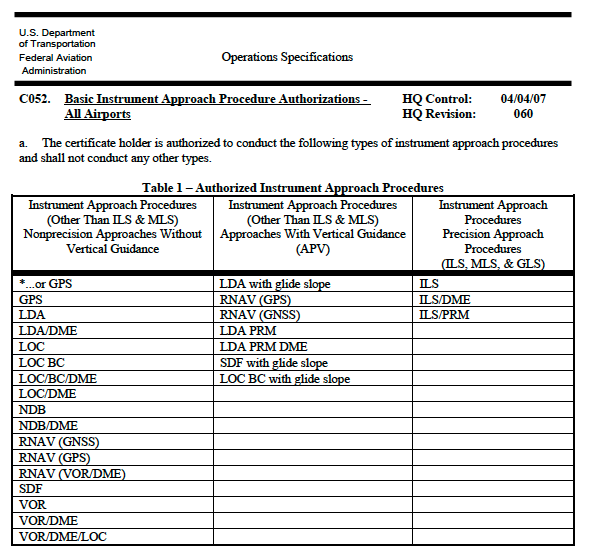If your airplane has been approved for RNAV (GPS) or RNAV (GNSS) approaches, and if you have been trained, then you are cleared in hot. Right? Not so fast.
— James Albright

Updated:
2016-18-14
We are of the mindset that GPS is more accurate than most so-called non-precision approaches, therefore we are always better off using GPS for any kind of approach. That isn't really true.

1
An example of confusion
I seem to get into this argument with instructors at FlightSafety a lot, so here goes:
They: "We can fly a VOR or NDB approach without GPS in the title using the FMS because the AFM says we can."
That isn't true, here is what the G450 AFM says, G450 Airplane Flight Manual, §1-34-30 ¶3.A.:
Don't fly a Gulfstream? Here is what Honeywell says: (from Honeywell Direct-To "Navaid Substitution"):
In plain and simple English, the non-RNAV approaches in the FMS navigation database have not been flight checked. When a radio-based approach is developed or revised, the responsible agency flight checks that procedure using raw data, but they provide no FMS “coding.” An aircraft’s data provider then codes the approaches so that they may be retrieved from the FMS. However, without a flight check that confirms the coding is correct, the regulatory agencies will not allow the approach to be flown down to the published minimums using only FMS guidance. Even though the data providers do an excellent job coding these procedures, raw data must still be monitored.
Don't fly a Honeywell system? Here is what the FAA says: From AC 90-108, ¶8.:
A lot of this confusion came from the temporary GPS overlay program which did allow the use of GPS for VOR approaches. But that program is over, the Advisory Circular (AC 90-94) was rescinded in 2009 and the AIM USED TO SAY:
The title of the remaining GPS overlay procedures has been revised on the approach chart to “or GPS” (e.g., VOR or GPS RWY 24). Therefore, all the approaches that can be used by GPS now contain “GPS” in the title (e.g., “VOR or GPS RWY 24,” “GPS RWY 24,” or “RNAV (GPS) RWY 24”).
Source: Aeronautical Information Manual 15 Dec 2015 ¶1-1-19.g.
But it doesn't say that anymore. Now it says you can fly other approaches using a suitable RNAV system provided the underlying navaid is operational and monitored. See New overlay procedures, below.
2
WGS-84
The navigation data published in the State AIP for the routes and supporting navigation aids must meet the requirements of Annex 15 — Aeronautical Information Services. All routes must be based upon WGS-84 coordinates.
Source: ICAO Doc 9613 ¶1.2.5.2
Navigation data may originate from survey observations, from equipment specifications/settings or from the airspace and procedure design process. Whatever the source, the generation and the subsequent processing of the data must take account of the following:
- all coordinate data must be referenced to the World Geodetic System — 1984 (WGS-84);
- all surveys must be based upon the International Terrestrial Reference Frame;
- all data must be traceable to their source;
- equipment used for surveys must be adequately calibrated;
Source: ICAO Doc 9613 ¶3.4
You cannot fly an RNAV (GPS) approach unless your aircraft database and the approach designers are using the same coordinate system. Chances are your airplane database uses the World Geodetic System of 1984 (WGS-84) so your approaches must also. The rules internationally depend on the country's WGS-84 status and national policy as found in their AIP and Jeppesen State pages.
More about this: WGS-84.
3
Making sense of approach types: RNAV(GPS)
"GPS" Absent From Title
The approach is named based on the NAVAIDs required for the final approach. If the term "GPS" is not in the title, you cannot use GPS to fly the approach.
Source: FAA-H-8261-1, Instrument Procedures Handbook, Pg 5-8
The "Presque Isle VOR DME RWY 1," for example, cannot be flown using GPS, you must use VOR and DME.
"RNAV" Appears in Title
The term "RNAV" allows pilots to use various means of area navigation, including but not requiring GPS. They enable specific VOR/DME RNAV equipment to create waypoints on the final approach path by virtually “moving” the VOR a specific DME distance along a charted radial.
Source: FAA-H-8261-1, Instrument Procedures Handbook, Pg 5-10
There aren't any examples to show as they have all been phased out.
"or GPS" Appears in Title
GPS overlay procedures that are based on pre-existing non-precision approaches contain the wording “or GPS” in the title. The title “VOR/DME or GPS A” denotes that throughout the GPS approach, the underlying ground-based NAVAIDs are not required to be operational and associated aircraft avionics need not be installed, operational, turned on, or monitored. The procedure can be used as a GPS approach or as a traditional VOR/DME approach and may be requested using “GPS” or “VOR/DME.”
Source: FAA-H-8261-1, Instrument Procedures Handbook, Pg 5-10
"GPS" Only in Title
Stand-alone GPS procedures are not based on any other procedures, but they may replace other procedures. The naming convention used for stand-alone GPS approaches is “GPS RWY XX.” The coding for the approach in the database does not accommodate multisensor FMSs because these procedures are designed only to accommodate aircraft using GPS equipment.
Source: FAA-H-8261-1, Instrument Procedures Handbook, Pg 5-10
"RNAV (GPS)" Approaches
RNAV (GPS) approach procedures have been developed in an effort to accommodate all RNAV systems, including multi-sensor FMSs. RNAV (GPS) IAPs are authorized as stand-alone approaches for aircraft equipped with RNAV systems that contain an airborne navigation database and are certified for instrument approaches. GPS systems require that the coding for a GPS approach activate the Receiver Autonomous Integrity Monitoring (RAIM) function, which is not a requirement for other RNAV equipment. The RNAV procedures are coded with both the identifier for a GPS approach and the identifier for an RNAV approach so that both systems can be used.
Source: FAA-H-8261-1, Instrument Procedures Handbook, Pg 5-10
4
New overlay procedures
a. 1−2−3. Use of Suitable Area Navigation (RNAV) Systems on Conventional Procedures and Routes
This change allows for the use of a suitable RNAV system as a means to navigate on the final approach segment of an instrument approach procedure (IAP) based on a VOR, TACAN, or NDB signal. The underlying NAVAID must be operational and monitored for the final segment course alignment.
Source: AIM 26 May 2016, Explanation of Changes.
Uses of Suitable RNAV Systems. Subject to the operating requirements, operators may use a suitable RNAV system in the following ways.
- Determine aircraft position relative to, or distance from a VOR (see NOTE 5 below), TACAN, NDB, compass locator, DME fix; or a named fix defined by a VOR radial, TACAN course, NDB bearing, or compass locator bearing intersecting a VOR or localizer course.
- Navigate to or from a VOR, TACAN, NDB, or compass locator.
- Hold over a VOR, TACAN, NDB, compass locator, or DME fix.
- Fly an arc based upon DME.
- The allowances described in this section apply even when a facility is identified as required on a procedure (for example, “Note ADF required”).
- These operations do not include lateral navigation on localizer−based courses (including localizer back−course guidance) without reference to raw localizer data.
- Unless otherwise specified, a suitable RNAV system cannot be used for navigation on procedures that are identified as not authorized (“NA”) without exception by a NOTAM. For example, an operator may not use a RNAV system to navigate on a procedure affected by an expired or unsatisfactory flight inspection, or a procedure that is based upon a recently decommissioned NAVAID.
- Pilots may not substitute for the NAVAID (for example, a VOR or NDB) providing lateral guidance for the final approach segment. This restriction does not refer to instrument approach procedures with “or GPS” in the title when using GPS or WAAS. These allowances do not apply to procedures that are identified as not authorized (NA) without exception by a NOTAM, as other conditions may still exist and result in a procedure not being available. For example, these allowances do not apply to a procedure associated with an expired or unsatisfactory flight inspection, or is based upon a recently decommissioned NAVAID.
- Use of a suitable RNAV system as a means to navigate on the final approach segment of an instrument approach procedure based on a VOR, TACAN or NDB signal, is allowable. The underlying NAVAID must be operational and the NAVAID monitored for final segment course alignment.
- For the purpose of paragraph c, “VOR” includes VOR, VOR/DME, and VORTAC facilities and “compass locator” includes locator outer marker and locator middle marker.
NOTE—
Source: AIM 26 May 2016, ¶1-2-3.c.
5
Making sense of approach types: RNAV(GNSS)
GPS is a subset of GNSS. In my opinion you can treat the RNAV (GNSS) as you would an RNAV (GPS), provided your aircraft is equipped and approved. See your AFM to be sure.
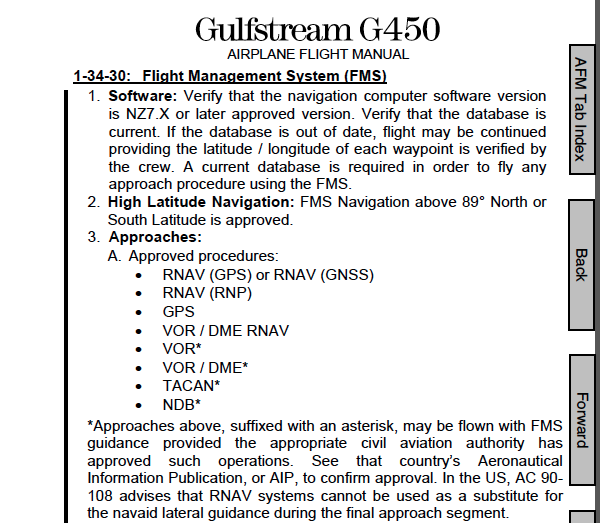
G450 approved procedures, from G450 Airplane Flight Manual, §1-34-30.
If your AFM or POH lists approved procedures, you need to see RNAV (GNSS) on the list or you can't fly them. If your AFM or POH doesn't list any approved procedures at all, well I guess it is open to question.
Commercial operators will need to have RNAV (GNSS) listed as an approved approach type in their operations specifications (C052, or equivalent).
The country in question must be WGS-84 compliant.
More about this: International Operations WGS-84.
You must comply with any additional requirements imposed by the host country, if any, as listed in their Aeronautical Information Publication or the Jeppesen State pages, Requirements and Regulations.
See RNAV (GNSS) Example for the process of determining if a RNAV (GNSS) approach is usable.
References
(Source material)
Advisory Circular 90-108, Use of Suitable Area Navigation (RNAV) Systems on Conventional Routes and Procedures, 3/3/11, U.S. Department of Transportation
Aeronautical Information Manual, 15 Dec 2015
Aeronautical Information Manual, 15 Dec 2015, Change 1, 26 May 2016
FAA-H-8261-1, Instrument Procedures Handbook, U.S. Department of Transportation, Flight Standards Branch, 2004
Gulfstream G450 Airplane Flight Manual, Revision 35, April 18, 2013
Honeywell Direct-To "Navaid Substitution", April 2015.
Please note: Gulfstream Aerospace Corporation has no affiliation or connection whatsoever with this website, and Gulfstream does not review, endorse, or approve any of the content included on the site. As a result, Gulfstream is not responsible or liable for your use of any materials or information obtained from this site.
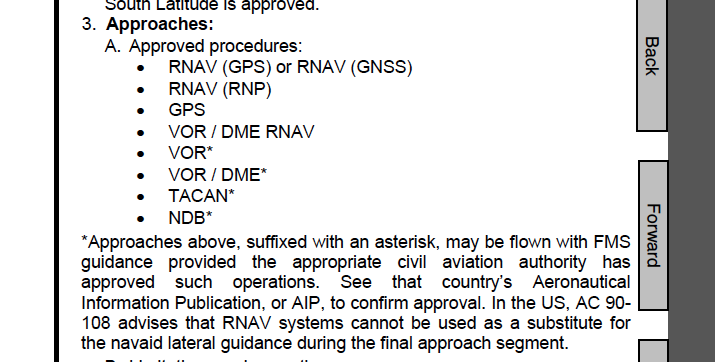
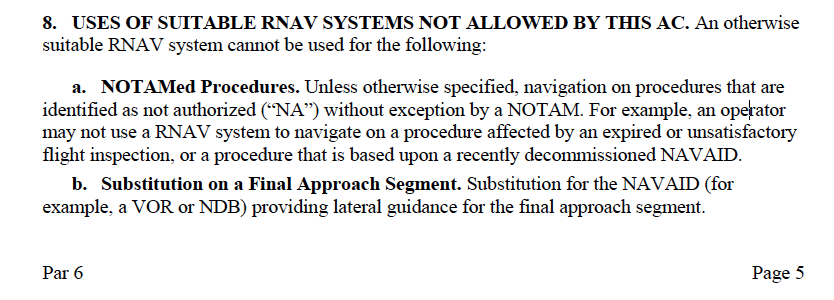
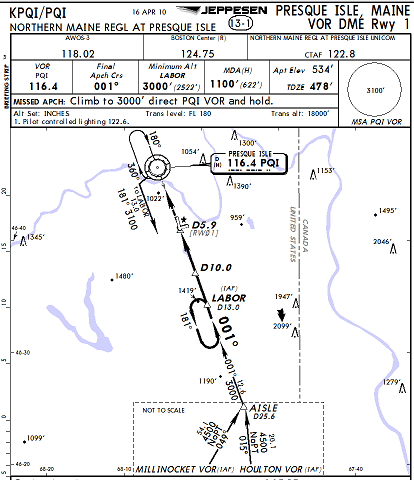
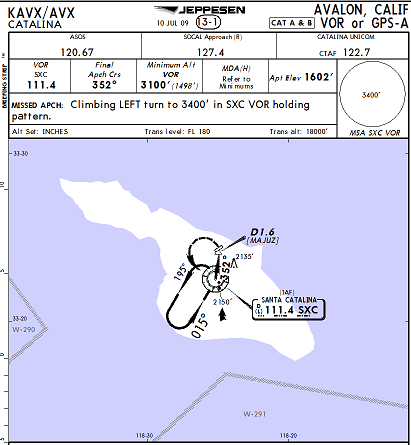
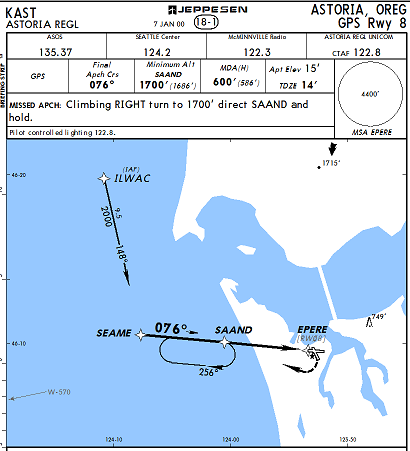
_rwy_01.png)
